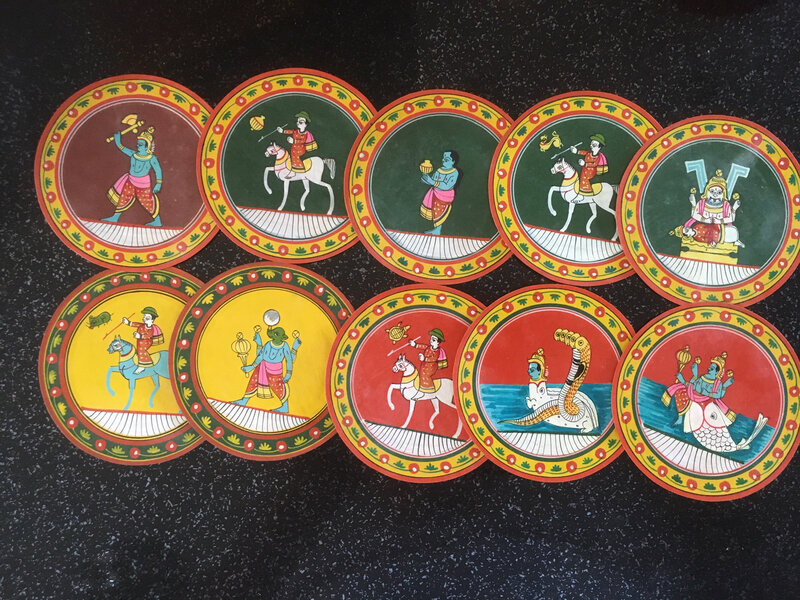ANCIEN JEU DE CARTES INDIENS MOGUL GANJIFA SAWANTWADI COLLECTOR PLAYING CARDS
Ganjifa, Ganjapa or Gânjaphâ, is a card game or type of playing cards that are most associated with Persia and India. After Ganjifa cards fell out of use in Iran during the twentieth century, India became the last country to produce them.
Ganjifa cards are circular or rectangular, and traditionally hand-painted by artisans. The game became popular at the Mughal court, and lavish sets were made, from materials such as precious stone-inlaid ivory or tortoise shell (darbar kalam). The game later spread to the general public, whereupon cheaper sets (bazâr kalam) would be made from materials such as wood, palm leaf, stiffened cloth or pasteboard. Typically Ganjifa cards have coloured backgrounds, with each suit having a different colour. Different types exist, and the designs, number of suits, and physical size of the cards can vary considerably. The backs of the cards are typically a uniform colour, without patterning.
Earlier History :
The earliest origins of the cards remain uncertain, but Ganjifa cards as they are known today are believed to have originated in Persia and became popular in India under the Mughal emperors in the 16th century. The term has been used at times in many countries throughout the Middle East and western Asia. The first known reference can be found in a 15th-century Arabic text, written by the Egyptian historian Ibn Taghribirdi (died 1470). In his history of Egypt he mentions how the Sultan Al-Malik Al-Mu'ayyad played kanjafah for money when he was an emir. A key reference comes from an early-16th century biography of Bâbur, the founder of the Mughal dynasty. Another reference from much the same period comes from a work by the Persian poet Ahli Shirazi (died 1535). In his poem 'Rubaiyat-e-Ganjifa' there is a short verse for each of the 96 cards in the 8-suited pack. When Edward Terry visited India in the first quarter of the seventeenth century, he saw ganjifa cards often.
Variant Cards are Moghul Ganjifa , Dashavatara Ganjifa , Ramayan Ganjifa , Rashi Ganjifa , Ashta Malla Ganjifa , Naqsh Ganjifa , Mysore Chad Ganjifa , Akbar's Ganjifa , Mamluk Kanjifa , French suited Ganjifa

/https%3A%2F%2Fstorage.canalblog.com%2F72%2F19%2F643459%2F62266743_o.jpg)


/https%3A%2F%2Fstorage.canalblog.com%2F94%2F21%2F643459%2F133601625_o.jpg)
/http%3A%2F%2Fstorage.canalblog.com%2F02%2F97%2F643459%2F122896969_o.jpg)
/https%3A%2F%2Fstorage.canalblog.com%2F21%2F22%2F643459%2F130015533_o.jpg)
/https%3A%2F%2Fstorage.canalblog.com%2F30%2F67%2F643459%2F84710550_o.jpg)